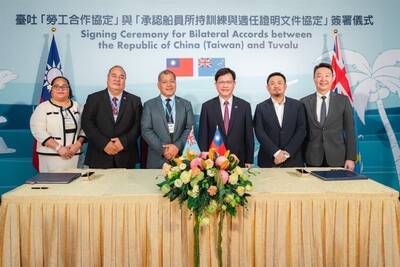The government will take out a total of NT$429 billion (US$13.4 billion) in loans for the next fiscal year to meet a shortfall in budget revenue, which will bring the nation’s total loans to an all-time high of NT$4.7 trillion, according to a Cabinet official yesterday.
“Although accumulated debt is approaching the cap, we will never exceed that,” Minister of Finance Lee Sush-der (李述德) said when asked if the government planned to revise the Public Debt Act (公共債務法), which sets the combined debt ceiling for the central government at 40 percent of average nominal GNP for the previous three years.
The NT$4.7 trillion loan accounts for 37.79 percent of GNP.
Lee made the remarks at a press conference following a Cabinet meeting during which a draft budget statement for next fiscal year was approved.
The Cabinet projected revenue for next year at NT$1.63 trillion and expenditure at NT$1.78 trillion, increasing from NT$1.55 trillion and NT$1.71 trillion respectively this year.
Of the NT$429 billion in loans, NT$159 billion is to meet the deficit between projected revenue and outlay, NT$60 billion is to pay for debt servicing and the remaining NT$204 billion is a special loan to fund public construction and flood-management projects.
Without the special loan, which is not subject to the debt-raising ceiling, loans to be taken out next year account for 12 percent of the outlay, lower than the cap of 15 percent.
Directorate-General of Budget, Accounting and Statistics Minister Shih Su-mei (石素梅) said the government has earmarked NT$3.2 billion for various activities to be held next year to celebrate the Republic of China’s centenary.
Of the government’s total outlay, spending on education, science and culture leads the pack with NT$357.3 billion, or 20 percent, followed by social welfare spending of NT$346.9 billion, or 19.4 percent, defense at NT$287.2 billion, or 16 percent, and economic development spending at NT$225.9 billion or 12.6 percent.
Defense spending accounted for 2.6 percent of GDP, less than 3 percent as promised previously by President Ma Ying-jeou (馬英九).

The Ministry of Economic Affairs has fined Taobao NT$1.2 million (US$36,912) for advertisements that exceed its approved business scope, requiring the Chinese e-commerce platform to make corrections in the first half of this year or its license may be revoked. Lawmakers have called for stricter enforcement of Chinese e-commerce platforms and measures to prevent China from laundering its goods through Taiwan in response to US President Donald Trump’s heavy tariffs on China. The Legislative Yuan’s Finance Committee met today to discuss policies to prevent China from dumping goods in Taiwan, inviting government agencies to report. Democratic Progressive Party Legislator Kuo Kuo-wen (郭國文) said

The Ministry of Economic Affairs has fined Taobao NT$1.2 million (US$36,900) for advertisements that exceeded its approved business scope and ordered the Chinese e-commerce platform to make corrections in the first half of this year or its license would be revoked. Lawmakers have called for stricter supervision of Chinese e-commerce platforms and more stringent measures to prevent China from laundering its goods through Taiwan as US President Donald Trump’s administration cracks down on origin laundering. The legislature’s Finance Committee yesterday met to discuss policies to prevent China from dumping goods in Taiwan, inviting government agencies to report on the matter. Democratic Progressive Party

Taiwan and its Pacific ally Tuvalu on Tuesday signed two accords aimed at facilitating bilateral cooperation on labor affairs, according to Taiwan’s Ministry of Foreign Affairs (MOFA). The governments inked two agreements in Taipei, witnessed by Foreign Minister Lin Chia-lung (林佳龍) and visiting Deputy Tuvaluan Prime Minister Panapasi Nelesone, MOFA said in a news release. According to MOFA, the agreements will facilitate cooperation on labor issues and allow the two sides to mutually recognize seafarers’ certificates and related training. Taiwan would also continue to collaborate with Tuvalu across various fields to promote economic prosperity as well as the well-being of their

Sung Chien-liang (宋建樑), who led efforts to recall Democratic Progressive Party (DPP) Legislator Lee Kun-cheng (李坤城), was released on bail of NT$80,000 today amid outcry over his decision to wear a Nazi armband to questioning the night before. Sung arrived at the New Taipei District Prosecutors’ Office for questioning in a recall petition forgery case last night wearing a red armband bearing a swastika, carrying a copy of Adolf Hitler’s Mein Kampf and giving a Nazi salute. Sung left the building at 1:15am without the armband and covering the book with his coat. Lee said today that this is a serious